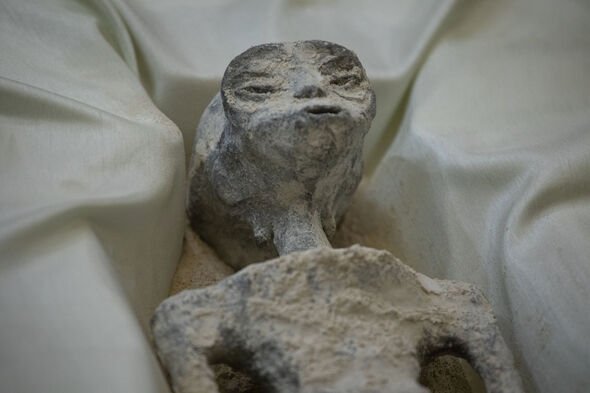World
Scientists Investigate Peru’s ‘Alien’ Mummies, Uncover DNA Insights

A remarkable investigation into a collection of mysterious mummies discovered in Peru has taken a significant turn, as scientists analyze DNA that challenges earlier theories of extraterrestrial origins. The remains, unearthed in 2015 by a grave digger in a cave, feature unusual anatomical traits, such as only three fingers and three toes. This unique morphology led to a flurry of speculation, with some suggesting these mummies could belong to aliens or a previously unknown human species, while skeptics dismissed them as elaborate hoaxes.
Currently, approximately two dozen of these mummies are undergoing thorough scientific analysis. Researchers report that the specimens retain preserved tissues, muscles, and organs, with one mummy believed to have been pregnant at the time of death.
DNA Analysis Points to Human Origins
Jesse Michels, host of the podcast *American Alchemy*, recently visited the site and shared his findings, stating that there is no evidence to support the alien hypothesis. Instead, he proposed that the mummies might represent a long-lost subterranean species. A bioinformatics expert, Alaina Hardie, conducted a detailed examination of publicly available DNA and identified a genetic mutation associated with a congenital condition that leads to digit deformities in humans.
“I set out to falsify the hypothesis that a mutation could explain such anomalies,” Hardie explained. “I found a list of 50 genes involved in the pathway.” Among these, the gene known as Gli3 was linked to polydactyly, a condition characterized by the presence of extra digits, which has been documented in archaeological findings in Peru.
Despite challenges related to contamination and the degraded state of the samples, genetic analysis revealed that the DNA from the mummies aligns predominantly with human genetic profiles. Scientists employed advanced extraction techniques to obtain genetic material from bone and muscle, followed by genome sequencing to construct genetic profiles and identify mutations.
One notable specimen, nicknamed “Victoria,” is a headless humanoid mummy whose DNA analysis also confirmed human origins. Michels drew parallels with a tribe in northern Zimbabwe affected by ectrodactyly, a condition that results in missing central digits, creating a distinctive cleft or V-shaped gap on the hands or feet. “There are mutations rendered adaptive in certain environments that persist over time,” he remarked, emphasizing the significance of these findings.
Hybrid Theories and Future Research
José Zace, chief of the Mexican Navy’s medical division and part of the research team, reported that the larger mummies contain 70 percent known DNA, with the remaining DNA being “completely different.” Dr. David Ruiz Vela, another lead researcher, suggested that some of the specimens might exhibit hybrid traits, potentially arising from migration and interbreeding between different primate or human species across Asia and Africa over the last 250,000 to 2,500 years.
To further investigate these intriguing findings, Michels plans to collaborate with Colossal Biosciences, an American genetic engineering firm recognized for its work on reviving extinct species. “They need permission from the Peruvian government to proceed,” he stated. “If the government won’t allow a top American biotech company to use their proprietary ancient DNA testing techniques on these mummies, that may indicate their stance on the matter.”
The mummies first gained international attention in 2022 when journalist Jaime Maussan presented several specimens to Mexico’s Congress, asserting their authenticity. A group of medical professionals backed his claims, stating that the bodies were once living beings. However, in 2023, controversy erupted when another journalist was found in possession of two “mummies” that were revealed to be wooden dolls crafted for tourist sales. Forensic archaeologist Flavio Estrada, who led the investigation, asserted that the claims of extraterrestrial origins were “totally false.”
“The conclusion is simple: they are dolls assembled with bones of animals from this planet, glued with modern synthetic adhesives,” Estrada stated, emphasizing that these findings contradict the narrative of alien involvement.
As the research continues, the narrative surrounding these enigmatic mummies remains dynamic, with ongoing studies seeking to uncover the truth behind their origins. The implications of these findings not only challenge popular theories but also contribute to a deeper understanding of human history and genetic diversity.
-

 Entertainment2 months ago
Entertainment2 months agoIconic 90s TV Show House Hits Market for £1.1 Million
-

 Lifestyle4 months ago
Lifestyle4 months agoMilk Bank Urges Mothers to Donate for Premature Babies’ Health
-

 Sports3 months ago
Sports3 months agoAlessia Russo Signs Long-Term Deal with Arsenal Ahead of WSL Season
-

 Lifestyle4 months ago
Lifestyle4 months agoShoppers Flock to Discounted Neck Pillow on Amazon for Travel Comfort
-

 Politics4 months ago
Politics4 months agoMuseums Body Critiques EHRC Proposals on Gender Facilities
-

 Business4 months ago
Business4 months agoTrump Visits Europe: Business, Politics, or Leisure?
-

 Lifestyle4 months ago
Lifestyle4 months agoJapanese Teen Sorato Shimizu Breaks U18 100m Record in 10 Seconds
-

 Politics4 months ago
Politics4 months agoCouple Shares Inspiring Love Story Defying Height Stereotypes
-

 World4 months ago
World4 months agoAnglian Water Raises Concerns Over Proposed AI Data Centre
-

 Sports4 months ago
Sports4 months agoBournemouth Dominates Everton with 3-0 Victory in Premier League Summer Series
-

 World4 months ago
World4 months agoWreckage of Missing Russian Passenger Plane Discovered in Flames
-

 Lifestyle4 months ago
Lifestyle4 months agoShoppers Rave About Roman’s £42 Midi Dress, Calling It ‘Elegant’









